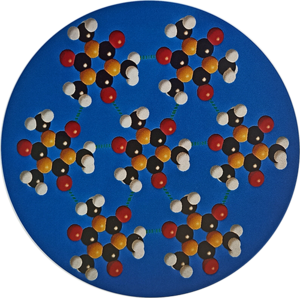Gautam R. Desiraju
This article has multiple issues. Please help improve it or discuss these issues on the talk page. (Learn how and when to remove these messages)
|
Gautam R Desiraju | |
|---|---|
 | |
| Born | August 21, 1952 Madras, Tamil Nadu, India |
| Alma mater | University of Bombay, University of Illinois |
| Known for | Crystal engineering, Hydrogen bonding |
| Scientific career | |
| Fields | Chemistry, X-ray crystallography |
| Institutions | Indian Institute of Science, University of Hyderabad |


Gautam Radhakrishna Desiraju (born 21 August 1952) is an Indian structural chemist and a professor at the Indian Institute of Science (IISc). He is known for his work on crystal bonding and weak hydrogen bonding.[1][2]
Biography
[edit]Gautam Desiraju was born in Chennai, India, He completed his schooling at Cathedral and John Connon Boys School in Bombay and obtained his BS in 1972 from St. Xavier's College, Mumbai. Under the guidance of David Y. Curtin and Iain C. Paul, he earned his PhD in 1976 from the University of Illinois at Urbana-Champaign. He worked between 1976 and 1978 in the Research Laboratories of Eastman Kodak Company in Rochester, NY. From 1978 to 1979, he was a research fellow at the Indian Institute of Science, Bangalore.
In 1979, he joined the University of Hyderabad as a lecturer, was promoted to reader in 1984, and became a professor in 1990. He spent a year (1988–1989) in the CR&D department of DuPont in Wilmington as a visiting scientist. After 30 years at the University of Hyderabad, he joined the Indian Institute of Science in Bangalore in 2009. He is the Editor-in-Chief of Polyhedron. He is a member of the editorial advisory boards of Chemical Communications and the Journal of the American Chemical Society. He served as president of the International Union of Crystallography from 2011 to 2014 and chaired the first Gordon Research Conferences in Crystal Engineering in 2010. He is a member of the Vice Chancellor's Strategic Advisory Council of the University of Petroleum & Energy Studies (UPES), Dehradun, and a member of the Academic Council of Rishihood University Sonepat.
Desiraju has received honorary doctorate degrees from Universidad Nacional de Córdoba, Argentina, Rayalaseema University, Kurnool, and Gulbarga University, Kalaburagi. In August 2017, he organized the 24th Congress and General Assembly of the International Union of Crystallography in Hyderabad.[3] He was awarded the Acharya P. C. Ray Medal (2015) by the University of Calcutta for innovation in science and technology, the ISA Medal (2018) for Science by the University of Bologna, and the Van der Waals Prize (2023) by ICNI, Strasbourg.[4][5]
Scholarly contributions
[edit]Desiraju's contributed to crystal engineering focusing on the concept of the supramolecular synthon.[6]
Desiraju has authored several commentaries on science, the evolution of chemistry as a subject,[7] emergence and complexity, and research habits and practices in various cultures.[8] He has also written articles about the state of science education and research in India[1][usurped] and the current status of chemistry research in the country,[9] identifying problems and suggesting solutions for issues partly rooted in traditional values while aspiring for contemporary advancements.
Despite being American-educated, Desiraju has advocated for inculcating a sense of "Indian-ness" in Indian students and young scientists will foster a modern competitive spirit and adherence to professionalism.[10][11]
References and notes
[edit]- ^ Desiraju, G. R.:"Bharat: India 2.0", Vitasta, 2022
- ^ Desiraju, Gautam R. (4 March 2023). "India with 75 states will lead to optimized growth and development". The Sunday Guardian Live. Retrieved 22 August 2024.
- ^ http://www.iucr2017.org [bare URL]
- ^ Desiraju, G. R.: "Crystal Engineering. The Design of Organic Solids", Elsevier, 1989.
- ^ Desiraju, G. R. and Steiner, T.: "The Weak Hydrogen Bond in Structural Chemistry and Biology", Oxford University Press, 1999.
- ^ Desiraju, G. R.: "Supramolecular Synthons in Crystal Engineering. A New Organic Synthesis", Angewandte Chemie International Edition Engl., 1995, 34, 2311.
- ^ Desiraju, G. R.: "Chemistry. The Middle Kingdom", Current Science, 2005, 88, 374.
- ^ Desiraju, G. R.: "Bold strategies for Indian science", Nature, 2012, 484, 159.
- ^ Arunan, E., Brakaspathy, R., Desiraju, G. R., Sivaram, S.: "Chemistry in India: Unlocking the Potential", Angewandte Chemie International Edition, 2013, 52, 114.
- ^ Prof. Gautam Desiraju's advice for young people: How to make India great again, 14 January 2023, retrieved 12 July 2023
- ^ Prof Desiraju Video Pondy Lit Fest 12 February 2023 on Bharat: India:2.0, 14 February 2023, retrieved 12 July 2023
